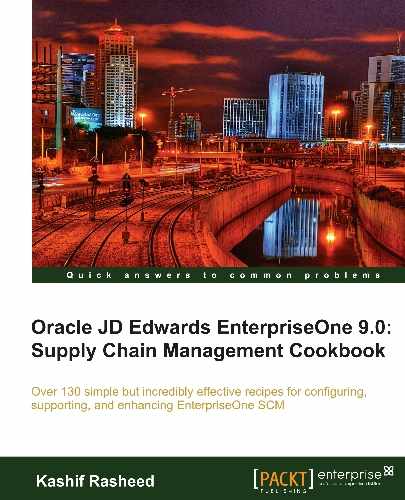A kit is a collection of inventory items that are associated with a parent item. Kits provide a way to:
- Package items together to be sold under a parent name
- Assemble a parent item from multiple inventory items
For example, you might store several computer components together, such as a monitor, hard drive, keyboard, and a mouse. When you sell the items, you might sell them collectively as a computer system. In another example, you might store the same computer components in different locations within a warehouse. By entering the components in the system as kit components, you can easily locate each item and assemble the final product. You do not stock the parent item as an inventory item.
Before setting up kit processing you need to :
- Enter item master records for kits
- Set up locations for kits
- Enter kit pricing information
- From Inventory Master/Transactions (G4111) | Item Master, on the Work With Item Master Browse form, click Add.
- Enter a code from the user-defined code list (UDC) 41/I, which indicates how you stock the item. The kit stocking type should be K. The stocking type is hard-coded and you should not change it.

- Enter a code that determines how the system calculates the price for kit items or configured items. Select the code as per your business requirement. You can see the valid values by pressing F1 with the cursor on Kit/Configuration Pricing Method.
- Enter a code that indicates whether the system maintains standard sales prices for an item, different sales prices for each branch/plant, or different sales prices for each location and lot within a branch/plant. The system maintains sales prices in the F4106 table.
- Select the values as per your business needs. You can see the valid values by pressing F1 with the cursor on the sales price level.
- Enter a code that indicates from where to retrieve the purchase price for an item when you enter a purchase order. You can see the valid values by pressing F1 with the cursor on the Purchase Price Level.
- On the Work With Item Branch form, select a component, and then select Item/ Branch from the Row menu, then Set up Locations for Kits.
If you assign a line type to a component, feature, or option, then when you enter each kit component, the system checks component item numbers against the Item Master (F4101) table. Kits can also contain non-stock components. In this case, the system does not validate the item numbers against the F4101 table. An example of a non-stock component is a flyer or catalog. Kits and bills of material can have up to 999 levels. A Level consists of Components, Features, and Options. Each level can consist of various parts. For example, you define a feature in a component of a parent kit and then enter the feature as a parent. The parent of the feature parent is the first level. The feature becomes a second level (a child of the first level).
Features and options are additional items for the kit. Feature items have a stocking type of F (for Feature). The system recognizes feature items as second-level parent items because the system does not carry inventory for the feature items. You set up the actual inventory items in the bill of material.
- Defining item information in Chapter 1,Inventory Management
